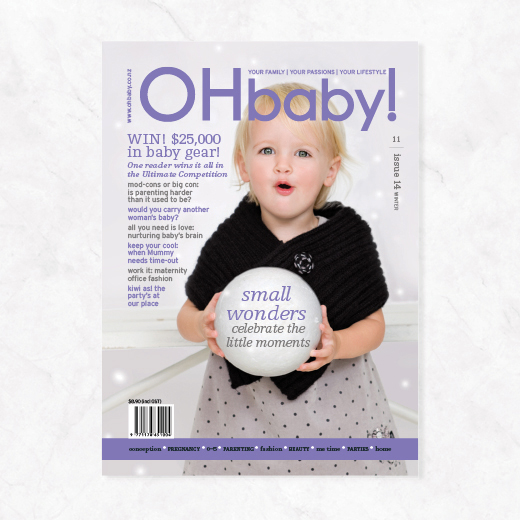Bosom buddies

Breasts are amazing. As soon as baby comes out they swing into action, producing a highly nutritious food. But while the breasts know what they're doing, the same can't be said for a first-time mum and newborn. Lactation consultant Maggie Morgan is here to help.
The process of breastfeeding can be fraught with problems, especially at the start, as Mum and baby learn the techniques required for ensuring a good feed without injury to the mother. Veteran midwife and consultant Maggie Morgan answers some of the commonly asked breastfeeding questions.
What is the best way to get my newborn to latch on?
The basic principles are: You should be in a comfortable position, usually sitting up with a flat lap and feet well supported. A pillow may help in the early days but remember, you won't want to be taking a pillow out and about.
Position the baby tummy to tummy so he is facing inwards. The most common starting position for breastfeeding is the cross-cradle position. Your arm should be along the baby's back with your hand around the base of the neck so the head can tilt gently back and the chin comes to the breast first. The other hand supports the breast. Your baby's chin should touch the breast below the nipple with the nipple pointing up towards the nose. Gently stimulate the baby by touching the mouth with the nipple until the baby opens his mouth wide. When the mouth is wide open, bring the baby onto the breast in a quick action. The baby should get a good mouthful of breast tissue. There will be some of the areola showing about where the nose is.
You need to wait until the baby has starting suckling well and there is no discomfort before moving the arm supporting the baby around so that the baby is cradled comfortably. If there is difficulty in latching in this position, try either the rugby hold or even lying down. It is important to get help at the start with latching to ensure breastfeeding gets off to the best possible start. The Ministry of Health has an excellent website (www.moh.govt.nz/breastfeeding) with good diagrams and information on positioning and attachment and it also has a DVD available to all pregnant women. Most hospitals and antenatal classes show DVDs on positioning and attachment. It helps to watch a DVD or attend a breastfeeding class antenatally. Positioning and attachment is usually taught at these classes.
How can I prepare for breastfeeding?
These days, nipple preparation is not generally recommended. Going back in time, preparation such as scrubbing with a nailbrush, using white spirit, oils or rolling or pulling out nipples was commonly suggested. However, now these methods are not recommended which is a great relief! You could start looking for good nursing bras. It pays to have a proper fitting to ensure it's comfortable.
How can I treat cracked or grazed nipples?
The best way is not to get them in the first place! Usually the baby has to draw the nipple towards the back of the mouth to maintain a good latch. If the baby does not have enough of the nipple in the mouth, the tongue will rub on the nipple and compress it against the hard palate which causes pain and damage. Most women get some discomfort when the baby first goes on the breast, but once the nipple is drawn to the back of the mouth, the discomfort should ease. It should not hurt all the way through a breastfeed. Remove the baby from the breast if the nipple is sore by putting a finger into the corner of the mouth to release the suction.
Research has shown that creams and ointments do not prevent sore or cracked nipples. It all goes back to making sure the latch is good. A pure lanolin ointment may offer some relief after feeding. These ointments have no smell or taste and that's important for the baby. I check whether the mother is allergic to lanolin first. Many creams are scented which may put a baby off and it is very important to read what is in these creams.
Once the baby is born, midwives will help mothers achieve good positioning and attachment and if there are still problems, will look for causes. You may be referred to a lactation consultant at this stage. The most common causes for cracked nipples after poor attachment are nipple thrush, possibly a tongue-tie in the baby, infection or vasospasm (a Raynauds type blanching of the nipple).
What is let-down and what causes it?
 Let-down is triggered by the release of the hormone oxytocin. This hormone contracts the cells surrounding the alveoli (where breast milk is produced) and releases the milk. You may feel this as a tingling or tightening. Some women feel it quite strongly while others never notice it occurring. It takes one or two minutes from stimulation for the release of oxytocin. When the baby is feeding, a mother will notice it sucking quite fast initially, then when the let-down occurs, he will start sucking in longer, deeper sucks with swallowing. The mother might notice she leaks from the other side while feeding. The release of oxytocin is in pulses - that is why the baby will often pause and then there will be another let-down. There are several let-downs in an average feed. Let-down is usually triggered by the baby crying or picking up the baby in readiness to feed. Touching the nipple or even thinking about the baby can trigger off this response. If the mother is stressed or in a lot of pain, for example from cracked nipples, sometimes this blocks the release of this hormone and so it may take time to get a let-down.
Let-down is triggered by the release of the hormone oxytocin. This hormone contracts the cells surrounding the alveoli (where breast milk is produced) and releases the milk. You may feel this as a tingling or tightening. Some women feel it quite strongly while others never notice it occurring. It takes one or two minutes from stimulation for the release of oxytocin. When the baby is feeding, a mother will notice it sucking quite fast initially, then when the let-down occurs, he will start sucking in longer, deeper sucks with swallowing. The mother might notice she leaks from the other side while feeding. The release of oxytocin is in pulses - that is why the baby will often pause and then there will be another let-down. There are several let-downs in an average feed. Let-down is usually triggered by the baby crying or picking up the baby in readiness to feed. Touching the nipple or even thinking about the baby can trigger off this response. If the mother is stressed or in a lot of pain, for example from cracked nipples, sometimes this blocks the release of this hormone and so it may take time to get a let-down.
How do I treat blocked milk ducts?
Some women are prone to these and seem to get them despite all measures. A blocked duct is usually caused by it not emptying properly. This can happen by having a bra that is too tight, or keeping a finger on the breast when the baby is feeding and blocking the drainage. Occasionally there are milk particles that may block a duct. The general advice is to keep feeding your baby and try using a warm facecloth, or stand in a warm shower, and massage gently over the area where the blocked duct is. Massaging the blocked duct when the baby is breastfeeding or when you're expressing may also help. If none of these work, sometimes hand-expressing can shift a blockage if it is in the nipple. Supply and demand controls a good milk supply. The more the baby feeds, the more milk is produced. If a woman misses out feeds or expressing, gradually her milk supply will drop. Usually the baby dictates the frequency of feeds and during growth spurts, which occur frequently in the first three months, they will have periods of frequent feeding.
How does milk supply work?
Every woman produces a different amount of milk over a 24-hour period. Some women can produce up to a litre a day, whereas other women may produce less than 400ml. Women who produce large quantities will breastfeed less frequently while other women will have to feed very frequently for the baby to get his daily requirements. Studies have looked at the milk volume and milk fat variation in breast milk and there is such a wide variation between women it is difficult to say whether milk supply is greater in the morning or at night. Often women notice that the babies feed more frequently in the late afternoon or early evening - this is a common pattern.
What can help with expressing?
It depends on whether you are expressing milk as a one-off or if it's ongoing because you are going back to work or have a premature baby. Often it helps to express after feeds during the day to build up enough for one feed if you're going out in the evening.
If you're going back to work, you may need to express three to four-hourly to maintain supply. If you have a premature baby, again we recommend three-hourly expressing during the day and four-hourly at night. Some mothers find expressing when they get up in the morning gives them more milk than at the end of the day. For expressing to work well, you need time, privacy and to be relaxed. I remember a working mother who said she had only a half-hour break and by the time she got to a private place, got her equipment ready, tried to relax knowing she had to be back at work, it took a while for the milk to let down. Having a picture of your baby, something that smells of him or just thinking about your little one may help. Gently massaging the breast before expressing may also help.
Good equipment is important. Some women find hand expressing can work well for them for short-term expressing. However, if a mother is returning to work or has a premature baby, a good pump is a worthwhile investment. A wide range of breast pumps is now available - from hand pumps to single electric or double electric pumps. These vary in price from around $100 to $700. There's brisk online trade in second-hand pumps but be careful if you choose this route. I have come across many women who have bought pumps over the internet and found there are parts missing.
What is the difference between fore milk and hind milk?
I try not to focus too much on fore milk and hind milk as some women can get quite confused by the whole issue. The basics are that at the beginning of the feed, the fat content of breast milk is lowest and during a feed, the fat content rises so it's highest at the end of the feed. This can vary from woman to woman.
Let the baby feed as much as he wants from the first breast before offering the second breast. Usually, the baby will slow down and take himself off when he's had enough. The average length of a feed is about 15-20 minutes, though some babies can feed in five minutes and others take up to an hour. Some babies will get all they need at a feed from one breast whereas other babies may require feeding from both breasts. Over time, breast milk production settles down to meet the demands of the baby. Colostrum, produced in the first few days after the birth, is high in protein, sodium, minerals and antibodies but low in carbohydrates, fats and vitamins. As the milk becomes mature milk, this changes and the milk looks almost watery but still has the right amount of proteins, vitamins, minerals, water, fats and calories a baby needs.
Why do some babies adjust easily to breastfeeding while their siblings have trouble?
There are different causes of painful or troublesome breastfeeding and it is certainly not unusual for one baby to have a lot of trouble while another is trouble-free. First, it is important to discount the common causes, poor latching, thrush, infection, tongue tie or vasospasm. Also I look to see what the birth history is. If a baby has had a difficult birth or an instrumental delivery, it may take a few days for the effects to settle down. For example, he may have a headache from a forceps or ventouse delivery. It can take up to four to six weeks for breastfeeding to settle down as Mum and baby adjust to the positioning and milk supply.
Also, take into account the baby's temperament. Some babies are calm and relaxed, whereas some can be tense, stressed babies. So even though they may be siblings, it is not uncommon for mothers to have different breastfeeding experiences with each baby.
Maggie Morgan (RN, RM, MA [Applied] IBCLC) has been a midwife for more than 30 years and a Plunket nurse and lactation consultant for 12 years. She has worked in a range of settings from maternity facilities, Plunket family centres, private practice, neonatal intensive care units and paediatric wards. She breastfed her own three children.

AS FEATURED IN ISSUE 14 OF OHbaby! MAGAZINE. CHECK OUT OTHER ARTICLES IN THIS ISSUE BELOW

















